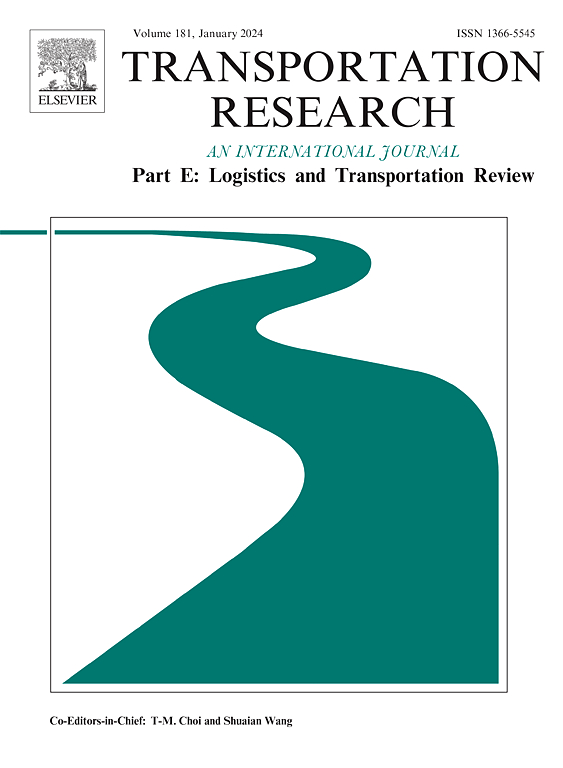Options of financing strategies: On the advantages of profit performance and signaling efficiency
IF 8.3
1区 工程技术
Q1 ECONOMICS
Transportation Research Part E-Logistics and Transportation Review
Pub Date : 2025-06-13
DOI:10.1016/j.tre.2025.104227
引用次数: 0
Abstract
In supply chains where downstream retailers, often small and medium-sized enterprises (SMEs), face capital limitations and information asymmetry, core enterprises (CEs) often aim to enhance overall performance by implementing financing assistance and conveying demand information They can choose to offer trade credit finance (TCF) or provide partial credit guarantee (PCG) financing as signaling mechanisms, but the effectiveness and profitability of these strategies remains unclear. To address this gap, this paper establishes an analytical model to compare and examine the signaling role and profitability of these financing strategies. Our findings indicate that CEs can credibly signal the demand state through both financing contracts, with signal distortions reduced through TCF for the CE and PCG for the retailer. Both supply chain members achieve a Pareto improvement by adopting PCG when production costs or interest rates are low, as the residual default loss exceeds the interest revenue or financing costs decline. Similarly, a Pareto improvement can be achieved through TCF when either production costs or interest rates are high, reducing the likelihood of bankruptcy or raising financing costs. Notably, PCG under information asymmetry achieves a larger win-win area compared to information symmetry. In addition, if the supply chain characteristics are interchanged, only TCF can achieve a Pareto improvement at a low financing rate. These insights shed light on the advantages of PCG and TCF for financing SMEs, offering valuable guidance for managers when selecting suitable financing strategies. This study contributes to understanding the signaling role of different financing strategies, specifically TCF and PCG, in supply chain contexts.
融资策略的选择:论利润绩效与信号效率的优势
在供应链中,下游零售商(通常是中小企业)面临资金限制和信息不对称,核心企业(ce)往往旨在通过实施融资援助和传递需求信息来提高整体绩效,它们可以选择提供贸易信用融资(TCF)或提供部分信用担保(PCG)融资作为信号机制,但这些策略的有效性和盈利能力尚不清楚。为了解决这一差距,本文建立了一个分析模型来比较和检验这些融资策略的信号作用和盈利能力。我们的研究结果表明,消费电子产品可以通过两种融资合同可靠地发出需求状态的信号,通过消费电子产品的TCF和零售商的PCG减少了信号失真。当生产成本或利率较低时,由于剩余违约损失超过利息收入或融资成本下降,两家供应链成员都采用PCG实现了帕累托改进。同样,当生产成本或利率较高时,通过TCF可以实现帕累托改进,从而降低破产的可能性或提高融资成本。值得注意的是,与信息对称相比,信息不对称下的PCG实现了更大的双赢区域。此外,如果供应链特征互换,只有TCF才能在较低融资率下实现帕累托改进。这些见解揭示了PCG和TCF在中小企业融资中的优势,为管理者选择合适的融资策略提供了有价值的指导。本研究有助于理解供应链背景下不同融资策略,特别是TCF和PCG的信号作用。
本文章由计算机程序翻译,如有差异,请以英文原文为准。
求助全文
约1分钟内获得全文
求助全文
来源期刊
CiteScore
16.20
自引率
16.00%
发文量
285
审稿时长
62 days
期刊介绍:
Transportation Research Part E: Logistics and Transportation Review is a reputable journal that publishes high-quality articles covering a wide range of topics in the field of logistics and transportation research. The journal welcomes submissions on various subjects, including transport economics, transport infrastructure and investment appraisal, evaluation of public policies related to transportation, empirical and analytical studies of logistics management practices and performance, logistics and operations models, and logistics and supply chain management.
Part E aims to provide informative and well-researched articles that contribute to the understanding and advancement of the field. The content of the journal is complementary to other prestigious journals in transportation research, such as Transportation Research Part A: Policy and Practice, Part B: Methodological, Part C: Emerging Technologies, Part D: Transport and Environment, and Part F: Traffic Psychology and Behaviour. Together, these journals form a comprehensive and cohesive reference for current research in transportation science.

 求助内容:
求助内容: 应助结果提醒方式:
应助结果提醒方式:


